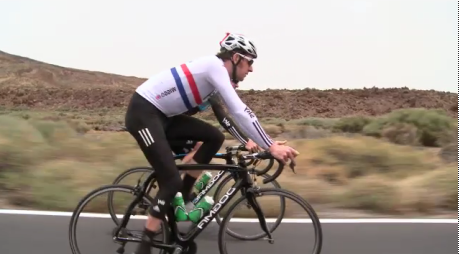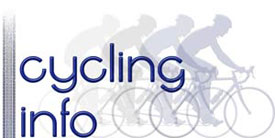Some training tips from Team Sky / British Cycling I’ve picked up from reading Cycling Weekly articles / interviews over past months and years.

Some Training Principles
Blocks of Three Days
Often training is concentrated into blocks of three hard days, followed by one day of recovery, then another three days hard training. The recovery day will still be on the bike, gently spinning. But the idea is the body responds best to those three consecutive days of hard training, during a particular training block. The idea is that three consecutive training days give maximum benefit. This principle of three days on, one day off, is used for a wide range of disciplines.
Time Trial Training
Bradley Wiggins dominated the 2012 time trial in the Tour de France, partly because he is so used to riding in that position. He spends several hours training on his time trial bike. One training ride involves cycling for a couple of hours at just below threshold level.
Before the British Time trial championships in 2011, Cycling Weekly reported on how Alex Dowsett and Steve Cummings prepared in the week leading up to the British time trial Championship. Firstly, they spent a whole week riding around the course – showing that for even a domestic race, they took it very seriously. The training was quite intense even for a one hour race. The day, before Cummings was doing a three hour ride to get the body ready for effort the next day.
Tour de France Preparation
- The preparation for the 2012 Tour de France was very specific. Bradley Wiggins raced less often, concentrating on stage races such as Paris-Nice, Criterium Dauphine and the Tour of Romandie. This gave Wiggins time to train at altitude and do race specific training to build up his climbing power.
- Starting back in November, Wiggins was doing lots of low-intensity work to build up his base endurance. This principle of building up base endurance is unsurprisingly very common as a training principle.
- Wiggins didn’t take the traditional 3 weeks off and start January in poor condition. Helped by a top swimming coach, he has adopted a strategy of training throughout whole year and being fit, even at the start of January.
- With this basic aerobic endurance, Wiggins later worked on his threshold power by doing long climbs at close to his anaerobic threshold. Throughout April and May, this involves doing 3-4 repetitions of 25 minute climbs.
- In his pre-tour training, Wiggins aimed at 100,000 metres of climbing to adapt his body to the toughest Tour de France stages where he might climb 4,000 metres during a 5-6 hour stage.
- A tour contender needs to be putting out a threshold power to weight ratio of around 6.7 watts per kilogram. Wiggins rode 2011, 10 mile TT at a power output of 476 watts, giving a watt per kilo of 6.57.
Bradley Wiggins Altitude Training
Bradley Wiggins and Chris Froome spent several weeks at a training camp in Tenerife. It gave him the opportunity to repeatedly climb long high climbs, to replicate climbs in the tour de France. Training at altitude makes the athletes ready for the shock of racing at altitude, with many climbs in the Tour peaking at over 2,000 metres. Without acclimatisation to altitude, athletes can find their oxygen saturation of their blood dropping.
- A key feature of Tenerife training camps is that riders can sleep at altitude and train on long climbs of up to 2,100 metres.
- Training at altitude help to increase red blood cell concentration, though this increase in red blood cells is concentrated on first two weeks of altitude.
- Training at altitude helps athletes to breath more deeply and improve performance of lungs. (interestingly reminds me of Obree breathing technique to use the whole of the lungs in breathing)
- Altitude helps improve the growth of capillary growth and the efficiency of oxygen uptake.
- Training at altitude can create minor hormonal changes, such as increased testosterone and cortisol., which helps build muscle.
- Sleeping at altitude helps maintain fitness. It creates greater stress on cardiovascular system to improve fitness with less muscular stress. It is like being in an altitude tent, but without noise and inconvenience.
- Training at altitude also has some disadvantages in that more stress is put on the body. But, the advantages from improved psyiological changes outweigh the stress on the body. Usually, a week of readaption to sea level is needed after a training camp.
Weight Loss
For track riders, weight loss is not so important. Power is the key thing and with no climbs, riders are often several Kgs heavier than road riders. However, making the switch to the Tour de France and weight becomes a key issue. Geraint Thomas noticed the shock to the system on his first Alpine passes. Losing weight helped him to be more competitive. In preparing for the Tour de France, Bradley Wiggins worked hard to lose a couple of Kgs, which can make all the different in the high Alps. Also, in 2012, Mark Cavendish adopted a new diet to help shift a few Kgs. The motivation was to be more competitive in the Olympic road race. Losing 4Kgs gives him a greater chance of staying in Peleton on box hill. To lose these 4Kgs, Mark Cavendish cut out sugar from his diet. He said it was hard, but worth the effort. As an added bonus, losing weight meant he suffered less in the Tour de France.
Bradley Wiggins Training
As mentioned in this key article the key aspects of Bradley Wiggins training are:
- Early season endurance sessions to build up aerobic base
- Training throughout the year, never allowing a prolonged rest and dip in form. As Wiggins says: “My coach has not been in cycling for long – he came from swimming – so I’m pretty much training like the swimmers train which is just constantly training through the year,” … “It’s just trying to be 95, 97 per cent all year and constantly working. The only downside is that it’s mentally difficult, but up to now I’ve found it pretty good. Team Sky feature
- Training at altitude to maximise benefits of altitude training
- Training camps to replicate mountaineous tour de France stages. This involves 5-6 hour rides with 4-5,000 metres of climbing. Perhaps 3 sessions of 25 minutes, riding close to threshold pace.
- In build up to Tour de France, Wiggins did close to 100,000 metres of climbing to fully adapt body to rigours of the tour.
- Time trial specific training Wiggins has been doing ever since early days of his cycling career. Wiggins has gained much from his
- Upper body core strength exercises to improve strength in mountains and on time trial bike
- Weight loss – to target optimal power to output ratio.
- Racing less to enable periods of downtime and recovery. “We’ve been racing to get a result and win and then having long periods of downtime and rest and recovery.”
Marginal Gains
The term marginal gains was coined by British Cycling and is associated with coach Dave Brailsford. It is the idea of looking at every aspect of cycling – bike design, clothes, nutrition, training and scrutinising every aspect of life to squeeze even the smallest gains from everywhere. If you aggregate all these small gains, it can make difference at top level. For example, this winter, Wiggins spent more time in gym (something he’s not been too keen on) to improve core body strength and improve climbing ability.
Marginal gains are scrutinised with great detail through power meters and to a lesser extent heart rate monitors. You often hear Sky riders talk enthusiastically about power readings – as if they were important as race results themselves. In a post race interview, Alex Dowsett seemed chuffed with churning out an average of around 312 watts during British road race championship.
Support Staff
It’s no secret Team Sky have a big budget and aren’t afraid to use it to offer every conceivable support to the riders. Wiggins talks about the care and attention to training from support staff.
“Anything I need is planned, it’s a lifestyle for everyone who works around me and it’s all for one cause.
“The way we do things, it’s fair to say we’re one of the most professional sporting teams in the world. That is one of the reasons why we have people who can compete across the board.
“The way we do the training camps through the winter months, the way every rider is looked after by someone within the team – their training is meticulously monitored. Brutal Training regime for Wiggins at British Cycling
3Km / 4 Km Pursuit
The 3Km / 4Km pursuit is still an endurance event, so the riders have been preparing for the Olympics with long training rides where the body gets used to long periods of lactic acid building up in the legs. The idea is to do long hill intervals, where the lactic aside accumulates, enabling the rider to gain improved lactic tolerance.
Doping Policy
I’ve always been convinced that British Cycling / Team Sky under Dave Brailsford have adopted a very strong anti-doping stance. What they say convinces that their efforts at marginal gains involve every legal effort. They haven’t quite been able to live up to intention of not employing anyone with any connection to doping. But, I do believe their anti-doping credentials are credible. Also, combined with stricter doping controls (since biological passports were introduced) this seems a much cleaner era in pro-cycling than say 10 years ago. It makes the achievements of British Cycling even more valuable. I’m sure there is someone on the internet who may disagree, but for what it’s worth – that’s my take.
Related

This is a really amazing article. Well done!
Sky’s approach to road cycling reminds me of the England cricket team’s methodology. Instead of relying on received wisdom, they both approach things very scientifically and quite coldly as well.
In cricket, rather than measuring performance in terms of runs and wickets, which are influenced by the opposition, they instead measure things like bowling accuracy over the course of a day. If a player performs well in this regard, they acknowledge it, even if the bowler has failed to take a wicket.
In cycling, I can’t imagine how detailed the facts and figures must be. I daresay Bradley Wiggins rides with total awareness of what power outputs he can maintain for what durations.
Yes, they have a very methodical approach and really take the data approach to knowing how someone is doing.